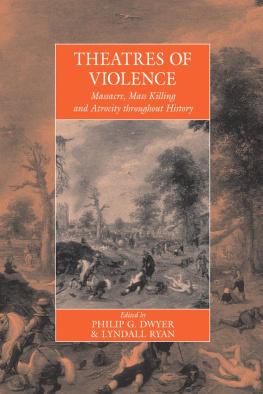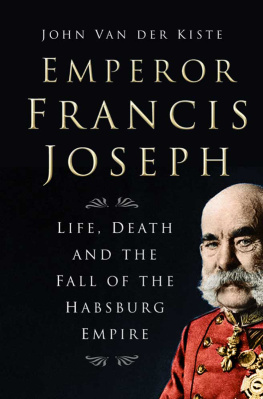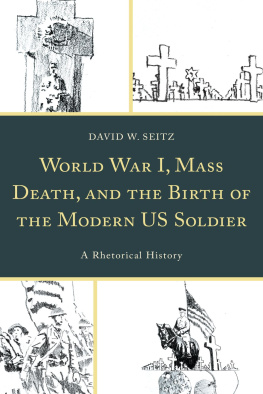POWER, VIOLENCE AND MASS DEATH IN PRE-MODERN
AND MODERN TIMES
First published 2004 by Gower Publishing
Published 2016 by Routledge
2 Park Square, Milton Park, Abingdon, Oxon OX14 4RN
711 Third Avenue, New York, NY 10017
Routledge is an imprint of the Taylor & Francis Group, an informa business
Copyright Joseph Canning, Hartmut Lehmann and Jay Winter 2004
The Editors have asserted their moral right under the Copyright, Designs and Patents Act, 1988, to be identified as the Editors of this work.
All rights reserved. No part of this book may be reprinted or reproduced or utilised in any form or by any electronic, mechanical, or other means, now known or hereafter invented, including photocopying and recording, or in any information storage or retrieval system, without permission in writing from the publishers.
Notice:
Product or corporate names may be trademarks or registered trademarks, and are used only for identification and explanation without intent to infringe.
British Library Cataloguing in Publication Data
Power, violence and mass death in pre-modern and modern times
1. War and society - Europe - History - 14th century 2. War
and society - Europe - History - 17th century 3. War and
society - Europe - History - 20th century 4. War
Psychological aspects 5. Disasters - Psychological aspects
6. War in art 7. War in literature 8. Europe - History
476-1492 9. Europe - History - 17th century 10. Europe
History - 20th century
I. Canning, Joseph II. Lehmann, Hartmut, 1936- III. Winter, J.M. 303.66
Library of Congress Cataloging-in-Publication Data
Power, violence, and mass death in pre-modern and modern times /edited by Joseph
Canning and Hartmut Lehmann and Jay Winter.
p. cm.
Includes bibliographical references and index.
ISBN 0-7546-3042-0 (alk. Paper)
1. Violence-Europe-History. 2. Violent crimes-Europe-History. 3.
GenocideEurope-History-20th century. 4. War. 5. Famines-Europe-History. 6. Social
classes-Europe-History. I. Canning, Joseph II. Lehmann, Hartmut, 1936-III. Winter, J.M.
HN380.Z9V547 2004
303.6094-dc22
2003057849
ISBN 13: 978-0-7546-3042-5 (hbk)
Contents
List of Figures and Tables
List of Contributors
Introduction: The Fourteenth, the Seventeenth and the Twentieth Centuries as Centuries of Violence and Mass Death
Hartmut Lehmann
PART I: Fourteenth Century
Joseph Canning
William Chester Jordan
Samuel K. Cohn, Jr.
A.D. Carr
PART II: Seventeenth Century
Hartmut Lehmann
Otto Ulbricht
Bernd Roeck
Markus Meumann
PART III: Twentieth Century
Tobias Jersak
Pieter Lagrou
Vejas Gabriel Liulevicius
Jay Winter
Joseph Canning, Department of History and Welsh History at the University of Wales Bangor, UK.
A.D. Carr, Department of History and Welsh History at the University of Wales Bangor, UK.
Samuel K. Cohn, Jr., Department of History at the University of Glasgow, UK.
Tobias Jersak, Department of History at the University of Stuttgart, Germany.
William Chester Jordan, Department of History at the Princeton University, USA.
Pieter Lagrou, Institut d histoire du temps prsent in Paris, France.
Hartmut Lehmann, Max-Planck-Institut fuer Geschichte in Goettingen, Germany.
Vejas Gabriel Liulevicius, Department of History at the University of Tennessee in Knoxville, USA.
Markus Meumann, Department of History at the Martin Luther University in Halle, Germany.
Bernd Roeck, Department of History at the University of Zuerich, Switzerland.
Otto Ulbricht, Department of History at the University of Kiel, Germany.
Jay Winter, Department of History at the Yale University, USA.
Introduction
The Fourteenth, the Seventeenth and the Twentieth Centuries as Centuries of Violence and Mass Death
Hartmut Lehmann
Medieval and modern European history can be conceived as a coherent sequence of developments or transformations with a number of caesurae which were important for the whole of Europe, as for example the Reformation or the French Revolution, and a whole series a minor caesurae with specific meanings for the history of individual European countries. By contrast, if one takes greater interest in the discussions and interpretations of historical typologies, one can also distinguish between phases of prosperity and phases of depression in European history, as well as between phases of violence and war and phases of tolerance and peace. If one takes this second approach, in the course of medieval and modern European history the fourteenth, the seventeenth and the twentieth centuries not only appear to be exceptional, but also somewhat related. First, the fourteenth century can be seen as an epoch in which widespread disease caused a demographic catastrophe, in which warfare was especially bitter and could not be contained for a long period of time, and in which religious minorities such as the Waldensians and the Jews were relentlessly persecuted. Second, the seventeenth century was an era in which the triple onslaught of disease, famine, and war caused dramatic demographic decline and widespread misery in many parts of Europe. And third, the twentieth century was a century characterized not only by two world wars, but also by unprecedented violence that culminated in several cases of genocide.
The contributions to this volume attempt to test the assumption that historians may be better equipped to understand the causes of the tragic turn of events in the twentieth century if they are able to grasp the relationship of power, violence, and mass death in earlier extraordinary centuries, such as the fourteenth and the seventeenth centuries. Yet the same may also result if one reverses the perspective: An analysis of power, violence, and mass death in the twentieth century may offer us new insights into the way these factors interacted as they altered the course of events in the fourteenth or in the seventeenth century.
The differences between the three centuries singled out here as periods that had traumatic consequences for large parts of European society, should, of course,not be underestimated. These differences did indeed exist, and it would be unwise to minimize them in order to establish a better basis for comparison. All those interested in the particulars of this research should turn to the impressive scholarly output on the crisis of the fourteenth century, to the no less important research on the crisis of the seventeenth century, and to the vast literature on the twentieth century as a century of extremes. However, in all this research, path-breaking as it may be from a methodological perspective, supposedly similar questions that arise through a comparison of these different centuries are not being addressed. Therefore, we have decided to raise some of these questions. Some of them may help us discover similarities between the fourteenth, the seventeenth and the twentieth centuries, while others may highlight differences and ways in which these similarities and differences might be related in various ways to social, political, intellectual, economic, and religious structures and transformations. More specifically, one should try to look into the causes of such transformations and ask whether we are able to perceive what one can call accelerated processes of transformation in areas such as population development, economic growthor more likely decline, political stabilityor rather instability, in religious commitment and in the search for new religious answers. In analysing the special character of the fourteenth, the seventeenth and the twentieth centuries, four aspects seem significant:










